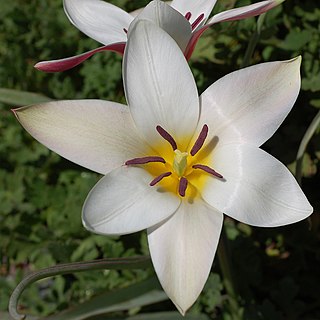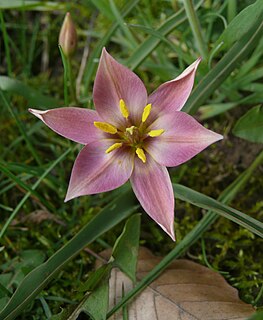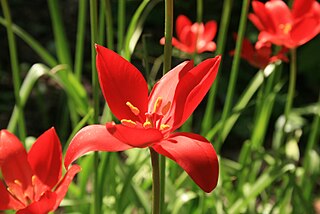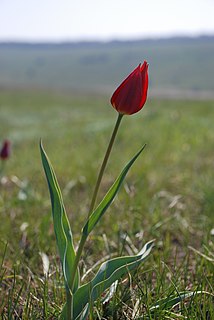
Muscari is a genus of perennial bulbous plants native to Eurasia that produce spikes of dense, most commonly blue, urn-shaped flowers resembling bunches of grapes in the spring. The common name for the genus is grape hyacinth, but they should not be confused with hyacinths. A number of species of Muscari are used as ornamental garden plants.

Theodor Heinrich Hermann von Heldreich was a German botanist born in Dresden.

Tulipa clusiana, the lady tulip, is an Asian species of tulip native to Afghanistan, Iran, Iraq, Pakistan and the western Himalayas. It is widely cultivated as an ornamental and is reportedly naturalized in France, Spain, Portugal, Italy, Tunisia, Greece, and Turkey.

Tulips (Tulipa) are a genus of spring-blooming perennial herbaceous bulbiferous geophytes. The flowers are usually large, showy and brightly colored, generally red, pink, yellow, or white. They often have a different colored blotch at the base of the tepals, internally. Because of a degree of variability within the populations, and a long history of cultivation, classification has been complex and controversial. The tulip is a member of the lily family, Liliaceae, along with 14 other genera, where it is most closely related to Amana, Erythronium and Gagea in the tribe Lilieae. There are about 75 species, and these are divided among four subgenera. The name "tulip" is thought to be derived from a Persian word for turban, which it may have been thought to resemble by those who discovered it. Tulips originally were found in a band stretching from Southern Europe to Central Asia, but since the seventeenth century have become widely naturalised and cultivated. In their natural state they are adapted to steppes and mountainous areas with temperate climates. Flowering in the spring, they become dormant in the summer once the flowers and leaves die back, emerging above ground as a shoot from the underground bulb in early spring.

Tulipa albanica is a flowering plant in the tulip genus, family Liliaceae that is native to Albania. It was discovered near the village of Surroj in Albania in 2010. The plant is a critically endangered (CR) as it grows in an area smaller than 100 ha, surrounded by mining activities.

Tulipa armena is a species of flowering plant in the Liliaceae family. It is referred to by the common name Armenian tulip, and is native to the historical Armenian Highlands as the name implies; current regions of Armenia, modern day Turkey, Iran, South Caucasus, and Azerbaijan.

Tulipa saxatilis is a Greek and Turkish species of plant in the genus Tulipa of the family Liliaceae.

Tulipa humilis is a species of flowering plant in the lily family, found in Syria, Lebanon, Israel, Turkey, Iran, and the North Caucasus region of Russia. The flowers are pink with yellow centers. Its preferred habitat are rocky mountain slopes. It is known by several other names in horticulture.

Tulipa sprengeri, or Sprenger's tulip, is a wild tulip from the Pontic coast of Turkey. It is quite rare and possibly extinct in the wild, but widely cultivated as an ornamental.

Tulipa suaveolens syn. Tulipa schrenkii, van Thol tulip, Schrenck's tulip, is a bulbous herbaceous perennial of species of tulip (Tulipa) in the family of the Liliaceae. It belongs to the section tulipa. It is the probable wild ancestor of the garden tulip.
Tulipa aleppensis is a wild tulip in the family Liliaceae. It is native to Southeastern Turkey, Syria, near Beirut in Lebanon.
Gagea amblyopetala is a Eurasian species of plants in the lily family, Liliaceae. It is native to the Aegean Islands, Albania, Crete, Crimea, Greece, Italy, Sicily, Turkey, Yugoslavia. It is a bulb-forming perennial with yellow flowers.

Tulipa sylvestris, the wild tulip or woodland tulip, is a Eurasian and North African species of wild tulip, a plant in the lily family. Its native range extends from Portugal and Morocco to western China, covering most of the Mediterranean and Black Sea Basins, and Central Asia. The species is also cultivated as an ornamental and naturalized in central and northern Europe as well as a few scattered locations in North America. It was first recorded as being naturalised in Britain in the late 17th century.

The taxonomy of Tulipa places the genus in the family Liliaceae, and subdivides it as four subgenera, and comprises about 75 species.

Tulipa montana is a species of tulip native to the mountains of Iran and Turkmenistan. With its deep red petals it has been proposed as a candidate for the Biblical Rose of Sharon, whose identity is unknown.

Tulipa biflora, the two-flowered tulip, is a species of tulip, native to the former Yugoslavia, Crimea, Anatolia, the Caucasus, southern Russia, Egypt, the Middle East, Central Asia, Iran, Pakistan, Afghanistan and Xinjiang in China. It has many synonyms, including Tulipa polychroma.

Tulipa fosteriana is a species of tulip, native to the Pamir Mountains and nearby areas of Afghanistan, Kyrgyzstan, Tajikistan and Uzbekistan.

Tulipa kaufmanniana, the water lily tulip, is a species of tulip native to Central Asia.

Tulipa praestans is a species of tulip native to the mountains of Tadzhikistan. Many well known cultivars have been formed from the original plant.

Tulipa bifloriformis is a species of tulip native to Central Asia. Its dwarfed 'Starlight' cultivar has gained the Royal Horticultural Society's Award of Garden Merit.



















